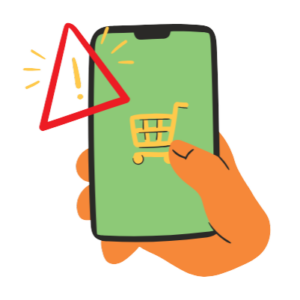
Social media is more than just a place for entertainment—it’s become a world-wide shopping mall in your pocket. Projected to hit a 1.2 trillion market value by 2025, social media platforms like TikTok and Instagram are now booming e-commerce sites, making shopping easier than ever.
However, scammers and threat actors can leverage the convenience of shopping on social apps to take advantage of unsuspecting shoppers. This is especially true during the Holiday Season, as consumers ramp up their purchases and look for unique gifts. By following our S.A.F.E. shopping framework, you can enjoy the best of social media shopping while avoiding common pitfalls.
S – Secure payment
A – Authentic sellers
F – Fraud awareness
E – Educate yourself and empower others
 Example of a S.A.F.E. shopping experience:
Example of a S.A.F.E. shopping experience:You’re scrolling on social media and see a video of an artist making custom shirts. The original video links directly to their in-app shop where you can read verified reviews, clear shipping policies. You use a secure payment gateway to place your order and when the shirt arrives, it looks just like the photos.
Safe shopping starts with secure payment processing. You can protect your banking information by always using trusted and secure payment gateways.
How to know you’re using a secure payment gateway:
Not every seller on social platform shops is legitimate.
Verify your seller and avoid fake accounts by looking for:
Fraudulent sellers often use similar tactics on social media to attract victims.
Avoid fraud by building awareness of these common red flags:
 Example of a fraudulent and unsafe shopping experience:
Example of a fraudulent and unsafe shopping experience:You click a TikTok Shop ad selling 80% off “high-quality leather boots” for the next two hours only! The link re-directs you to an unknown website where you need to re-enter your shipping and payment information. After placing the order, your boots arrive weeks late and look nothing like the video. Now, you’ve started to get unauthorized charges on your credit card.
The power of social media can help others avoid scams and find trustworthy sellers.

Don’t be embarrassed. You’re not alone—social media scams accounted for $1.4 billion in losses in 2023.
Follow these simple steps to protect yourself and others.
We’ve got answers — fast, clear, and tailored to your needs. Let’s talk tech.
